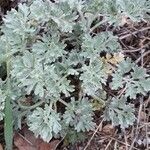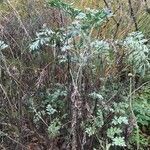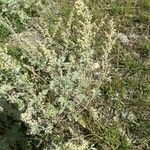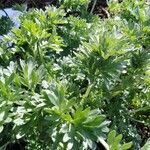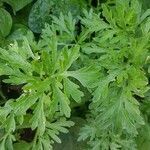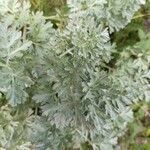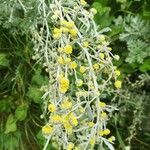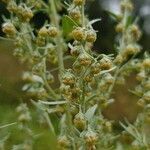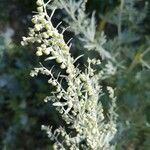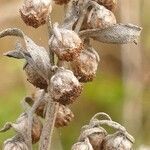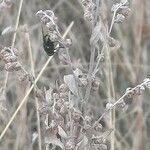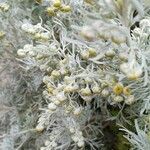Strongly aromatic, herbaceous perennial, dying back ± to woody stem bases each year. Stems ascending to erect, densely sericeous, becoming glabrous below, ribbed, up to c. 1 m long, much-branched toward base. Lvs scattered along stems, densely sericeous on upper and lower surface. Lower cauline lvs petiolate, 1-pinnate with leaflets 2-(3)-pinnatisect, up to c. 30 × 20 cm in lower lvs; ultimate segments oblong-ovate, obtuse, 5-10-(18) × (1)-2-4-(6) mm, with only the central vein evident. Infl. paniculate; infl. lvs similar to cauline lvs but becoming apetiolate and 1-pinnatisect, finally reduced to < 1 cm long and not lobed. Outer involucral bracts herbaceous or with membranous apex, sericeous; inner bracts sparsely hairy, with broad membranous margins and apex. Capitula 2-4-(5) mm diam.; receptacle pilose; florets many, dull yellow, glabrous. Achenes 0.8-1.3 mm long, brown, obovoid, ± terete, smooth; pappus 0.
Perennial herb or near-shrub 4–10 dm, the stem finely sericeous or eventually glabrate; lvs silvery-sericeous, sometimes eventually subglabrate above, the lower long-petiolate and 2–3 times pinnatifid, with mostly oblong obtuse segments 1.5–4 mm wide, the blade rounded-ovate in outline; upper lvs progressively less divided and shorter-petiolate, the segments often more acute; infl ample, leafy; involucre 2–3 mm; receptacle beset with numerous long white hairs between the fls; achenes nearly cylindric, but narrowed to the base and rounded at the top; 2n=18. Fields and waste places; native of Europe, now established across n. U.S. and adj. Can., throughout our range. July–Sept.
Perennials, 40–60(–100) cm (mat-forming), aromatic. Stems gray-green (sometimes woody proximally), densely canescent to glabrescent (hairs appressed). Leaves deciduous, gray-green; blades broadly ovate, 3–8 × 1–4 cm, mostly pinnately lobed (basal 2–3-pinnatifid, lobes obovate), faces densely canescent. Heads (nodding) in open (diffusely branched), paniculiform arrays 10–20(–35) × (2–)10–13(–15) cm. Involucres broadly ovoid, 2–3 × 3–5 mm. Phyllaries gray-green, densely sericeous. Florets: pistillate 9–20; bisexual 30–50; corollas 1–2 mm, glandular. Cypselae (± cylindric, slightly curved, obscurely nerved), ± 0.5 mm, glabrous (shiny). 2n = 18.
A perennial herb. It grows 60-90 cm high and 50-60 cm wide. It has a woody base. The leaves are finely divided and silvery. It spread by rhizomes or underground stems. The stems above ground can also form roots. The flowers are in flower heads which occur in sprays. They are dull yellow.
